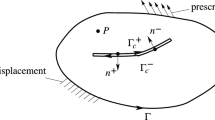Abstract
Purpose
According to the interaction between multiple cracks, a method for calculating the stress intensity factors of multiple closed collinear cracks in an infinite plate is proposed. In addition, the effects of the crack angle, crack length, crack spacing, lateral pressure coefficient and crack surface friction coefficient on the stress intensity factors are analyzed.
Method
The integral equation of the stress intensity factors is derived by the superposition principle, and the approximate solution of the integral equation is derived by the Chebyshev polynomial. The results obtained are compared with the finite element solutions of the same problem and the solutions of other scholars to verify the correctness of the equation.
Results
The results show that the intensity factor solution obtained by the proposed method is in good agreement with the finite element solution and other scholars’ solutions. A larger crack length, smaller crack spacing, smaller friction coefficient and smaller lateral pressure coefficient can produce larger stress intensity factors, and the stress intensity factors are maximized when the crack angle is 45°.
Conclusions
It is proved that the method based on the initial solution and superposition principle can be effectively applied to the calculation of the stress intensity factors of multiple collinear cracks.







Similar content being viewed by others
Data Availability
The data used to support the findings of this study are available from the corresponding author upon request.
References
Zhao Y, Zhang C, Wang Y et al (2021) Shear-related roughness classification and strength model of natural rock joint based on fuzzy comprehensive evaluation. Int J Rock Mech Min Sci 137:104550
Zhao Y, Wang Y, Wang W et al (2019) Modeling of rheological fracture behavior of rock cracks subjected to hydraulic pressure and far field stresses. Theoret Appl Fract Mech 101:59–66
Muskhelishvili NI (1953) Some basic problems of the mathematical theory of elasticity. Noordhoff, Groningen
Muskhelishvili NI, Radok JRM (2008) Singular integral equations: boundary problems of function theory and their application to mathematical physics. Courier Corporation, North Chelmsford
Hasan S, Akhtar N (2015) Dugdale model for three equal collinear straight cracks: an analytical approach. Theoret Appl Fract Mech 78:40–50
Koiter WT (1959) An infinite row of collinear cracks in an infinite elastic sheet. Ingenieur-Archiv 28(1):168–172
Kachanov ML (1982) A microcrack model of rock inelasticity part I: frictional sliding on microcracks. Mech Mater 1(1):19–27
Kachanov M (1987) Elastic solids with many cracks: a simple method of analysis. Int J Solids Struct 23(1):23–43
Li YP, Tham LG, Wang YH et al (2003) A modified Kachanov method for analysis of solids with multiple cracks. Eng Fract Mech 70(9):1115–1129
Erdogan F (1962) On the stress distribution in plates with collinear cuts under arbitrary loads. 4th US Nat. Congr. Appl. Mech, New York, pp 547–553
Dao WR (1997) The stress intensity factors of a rectangular plate with collinear cracks under uniaxial tension. Eng Fract Mech 56(3):347–356
Dao WR (1994) Solution for an infinite plate with collinear radial cracks emanating from circular holes under biaxial loading by boundary force method. Eng Fract Mech 48(1):119–126
Zhu Z, **e H, Ji S (1997) The mixed boundary problems for a mixed mode crack in a finite plate. Eng Fract Mech 56(5):647–655
Chen CS, Pan E, Amadei B (1998) Fracture mechanics analysis of cracked discs of anisotropic rock using the boundary element method. Int J Rock Mech Min Sci 35(2):195–218
Pattanayak P, Kulkarni SS (2022) Efficient computation of dynamic stress intensity factors for problems with stationary cracks subjected to time dependent loading. J Vibration Eng Technol. https://doi.org/10.1007/s42417-022-00530-y. Accessed 15 May 2022
Lauterbach B, Gross D (1998) Crack growth in brittle solids under compression. Mech Mater 29(2):81–92
Ballarini R, Plesha ME (1987) The effects of crack surface friction and roughness on crack tip stress fields. Int J Fract 34(3):195–207
Eberhardt AW, Kim BS (1998) Crack face friction effects on mode II stress intensities for a surface-cracked coating in two-dimensional rolling contact. Tribol Trans 41(1):35–42
Manouchehrian A, Sharifzadeh M, Marji MF et al (2014) A bonded particle model for analysis of the flaw orientation effect on crack propagation mechanism in brittle materials under compression. Arch Civil Mech Eng 14(1):40–52
Zhu Z (2009) An alternative form of propagation criterion for two collinear cracks under compression. Math Mech Solids 14(8):727–746
Zheng T, Zhu Z, Wang B et al (2014) Stress intensity factor for an infinite plane containing three collinear cracks under compression. ZAMM J Appl Math Mech 94(10):853–861
Chen YZ (1984) General case of multiple crack problems in an infinite plate. Eng Fract Mech 20(4):591–596
Fan Y, Zhu Z, Kang J et al (2017) The mutual effects between two unequal collinear cracks under compression. Math Mech Solids 22(5):1205–1218
Funding
This work was financially supported by the Project of National Natural Science Foundation of China (NO. 51904012), the Key Projects of Natural Science Research in Colleges and Universities in Anhui Province (KJ2019A0099), and the scientific research activities of postdoctoral researchers in Anhui Province (2018B268).
Author information
Authors and Affiliations
Corresponding author
Ethics declarations
Conflict of interest
The authors declare that the research was conducted in the absence of any commercial or financial relationships that could be construed as a potential conflict of interest.
Additional information
Publisher's Note
Springer Nature remains neutral with regard to jurisdictional claims in published maps and institutional affiliations.
Rights and permissions
Springer Nature or its licensor (e.g. a society or other partner) holds exclusive rights to this article under a publishing agreement with the author(s) or other rightsholder(s); author self-archiving of the accepted manuscript version of this article is solely governed by the terms of such publishing agreement and applicable law.
About this article
Cite this article
Peng, S., **g, L., Li, S. et al. Analytical Solution of the Stress Intensity Factors of Multiple Closed Collinear Cracks. J. Vib. Eng. Technol. 11, 3737–3745 (2023). https://doi.org/10.1007/s42417-022-00779-3
Received:
Revised:
Accepted:
Published:
Issue Date:
DOI: https://doi.org/10.1007/s42417-022-00779-3



